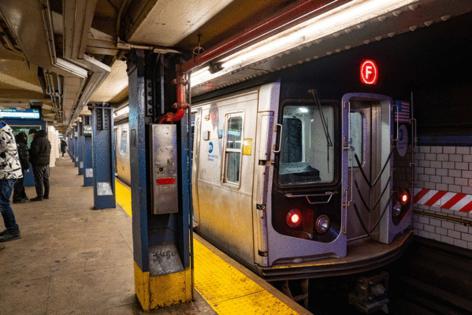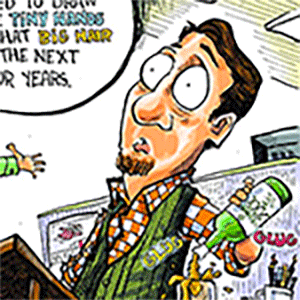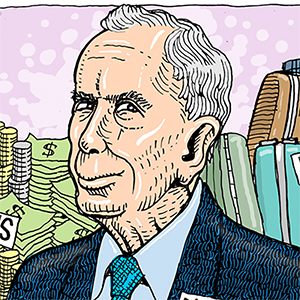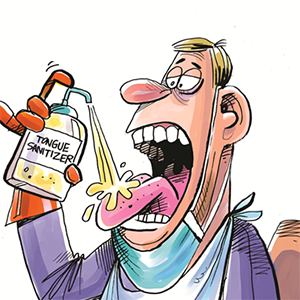Justin Fox: NYC's subway is actually safer than your car
Published in Op Eds
At a hearing of the House Committee on Transportation and Infrastructure in Washington last week, Representative Jerry Nadler of Manhattan and Secretary of Transportation Sean Duffy squared off over the safety of New York City’s subways. A snippet:
NADLER: Are you aware that major crimes on MTA are down 3% since last year and down 8% since 2019?
DUFFY: No, that’s wrong. The assaults we’ve seen are up 60%
NADLER: Why do you continue to lie about this?
DUFFY: Why do you continue to lie about people being lit on fire on subways?
The number of major felonies on the subway is in fact down this year and down since 2019 (by 3.9% and 7.3%, respectively, as of the end of May, according to the most recent crime report provided by the New York City Police Department to the board of the Metropolitan Transportation Authority).
But felony assaults on the subway in the first five months of this year were up 18% compared with the same period last year and 66% compared with the same period in 2019. Nobody was lying. Both Nadler and Duffy were making valid claims about subway crime, even if their numbers don’t appear to be entirely up to date.
Was one claim more valid than the other? Given how much subway ridership has fluctuated over the past five years, it’s best to measure crime relative to ridership, and that makes the situation underground in New York City look dicier. The major felonies rate is falling this year as it has every year since 2021, but it’s up 13% since 2019. The felony assault rate is rising this year and is up 128% since 2019.
One thing this chart makes clear is that in most years grand larceny — theft of items worth $1,000 or more — makes up the majority of major subway crime and thus plays an outsized role in determining the major felony totals that Nadler cites. Grand larceny has been falling relative to ridership since 2022, and the rate so far this year is the lowest since 2010.
Robbery rates have been falling, too, and are close to pre-pandemic levels. Crime for profit on the subway is thus not bad by historical standards and on the decline (burglary shows no clear trajectory but is so rare in the subway system, which is low on attractive burglary targets, as to be effectively irrelevant). As I wrote in a similar review of subway crime two years ago, it’s the other crimes — violent, mostly senseless crimes — that continue to be a problem. Giving each major felony category its own mini-chart makes this clearer.
Concerns about subway violence are thus not misplaced, and Nadler’s attempts to dismiss them fall flat. That said, Duffy’s concerns seem to be mostly grandstanding. He isn’t offering Transportation Department aid to combat the problem. Instead, he’s been making threatening gestures in the direction of the MTA, which is controlled by New York Governor Kathy Hochul, when it is the NYPD that’s chiefly responsible for public safety on the subway. Not entirely coincidentally, the police department reports to New York City Mayor Eric Adams, who has been on friendly terms with the Trump administration since the Justice Department dropped corruption charges against him early in Trump’s second term.
The problem on the subway is the same as it is aboveground in New York City, where felony assaults are much more common than before the pandemic and not declining at the pace of other violent crime (down 1.1% through July 13 compared with a decline of 26.5% for murder and a 12.4% drop for robbery). There are too many troubled, angry people on the city’s streets and subway platforms these days.
Why is that? Deinstitutionalization, which accelerated abruptly when COVID-19 first arrived; the social and economic disruption of the pandemic; the pullback in law enforcement during the pandemic; and some not especially well thought out aspects of the New York state bail reforms enacted in 2019 are potential causes that spring to mind. You can probably think of others. Elected officials in New York are not unaware of this mental-health crisis and have taken some actions to address it, but they could do more and could use some help.
Meanwhile, Duffy’s crusade against the MTA’s new Manhattan congestion pricing scheme — which has so far succeeded in reducing traffic, increasing subway and bus use and raising hundreds of millions of dollars for transit improvements — will, if successful, probably make New Yorkers both below and above ground less safe.
That’s because traveling in the subway remains much less dangerous than getting around by car. It is awful and unacceptable that 10 people were murdered in the subway system in 2024. Convert that to the standard way of measuring mortality risk, deaths per 100,000 population, and the risk for someone who rode the subway 500 times in 2024 is 0.4 in 100,000. Here’s how that compares with some other mortality risks in New York City, the US, the Wisconsin county where Duffy was born and raised, and the adopted home county of his boss, former New Yorker Donald Trump.
Even for a moderately heavy subway user (it’s my chief means of getting to work and around the city, although I bike a fair amount as well, and according to my credit card receipts I have been on it about 300 times in the past 12 months), the risk of being murdered underground is much less than that of being murdered elsewhere in the city, and orders of magnitude less than the risk of dying from a traffic accident elsewhere in the U.S. Cars are deadly, and any transportation policy that encourages their use over public transportation is pretty much by definition anti-safety.
Accidents do happen on the subway, too, with the Centers for Disease Control and Prevention reporting that 35 people died in railroad accidents in New York City in 2024, almost double 2019’s total of 18. But my impression is that almost all of these deaths involved people taking deliberate and often crazy risks — standing between cars, walking on the tracks, “subway surfing” and the like. Normal subway riders are at almost zero risk of accidental death.
The CDC gets its data from death certificates, and the mortality rates reported in the chart are for residents of the country, county or city. The 2024 numbers are not absolutely, positively complete yet, but they’re pretty close. The numbers for Sawyer County, Wisconsin, are seven-year averages because the CDC suppresses deaths data for privacy reasons when there are fewer than 10, and with only 18,835 residents, Sawyer County never reaches that threshold in the single-year traffic accident or homicide data.(1) In recent years the CDC has also started reporting deaths by where they occurred, but the numbers usually don’t differ much from those for residents. One significant exception is New York City traffic deaths, with the CDC reporting 328 deaths of New Yorkers in 2024 but only 275 caused by accidents occurring in the city.
Leaving New York City is dangerous, and a transportation secretary truly concerned about safety wouldn’t be trying to scare people away.
(1) It actually doesn't reach it in the seven-year homicide data either, but there are sneaky ways to get around that.
_____
This column reflects the personal views of the author and does not necessarily reflect the opinion of the editorial board or Bloomberg LP and its owners.
Justin Fox is a Bloomberg Opinion columnist covering business, economics and other topics involving charts. A former editorial director of the Harvard Business Review, he is author of “The Myth of the Rational Market.”
_____
©2025 Bloomberg L.P. Visit bloomberg.com/opinion. Distributed by Tribune Content Agency, LLC.

























































Comments